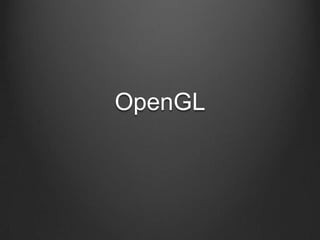
Opengl presentation
- 1. OpenGL
- 2. Opengl OpenGL has been around for over 16 years. Its development is overseen by the Khronos group. OpenGL has undergone some radical changes in its most recent release.
- 3. OpenGL Architecture internal state machine In programmable it is up to the programmer to not only pass in the correct information (for example the color of the vertex) but also apply this information to the vertex in the shader.
- 5. Pipeline
- 7. Related Libraries GLUT (OpenGL Utility Toolkit) SDL
- 8. GLUT OpenGL Utility Toolkit windowing, menus, or input
- 9. SDL The Simple Direct Media Layer audio, input, 2D graphics, and many other things
- 10. WGL prevent multiple OpenGL applications from interfering with each other. This is done through the use of a rendering context Only one rendering context per thread. HGLRC wglCreateContext(HDC hDC); BOOL wglDeleteContext(HGLRC hRC); BOOL wglMakeCurrent(HDC hDC, HGLRC hRC);
- 12. Pixel Formats typedef struct tagPIXELFORMATDESCRIPTOR { WORD nSize; WORD nVersion; DWORD dwFlags; BYTE iPixelType; BYTE cColorBits; BYTE cRedBits; BYTE cRedShift; BYTE cGreenBits; BYTE cGreenShift; BYTE cBlueBits; BYTE cBlueShift; BYTE cAlphaBits; BYTE cAlphaShift; BYTE cAccumBits; BYTE cAccumRedBits; BYTE cAccumGreenBits; BYTE cAccumBlueBits; BYTE cAccumAlphaBits; BYTE cDepthBits; BYTE cStencilBits; BYTE cAuxBuffers; BYTE iLayerType; BYTE bReserved; DWORD dwLayerMask; DWORD dwVisibleMask; DWORD dwDamageMask; } PIXELFORMATDESCRIPTOR;
- 13. Pixel Formats nSize dwFlags iPixelType PFD_TYPE_RGBA. RGBA pixels. Each pixel has four components in this order: red, green, blue, and alpha. PFD_TYPE_COLORINDEX. Paletted mode. Each pixel uses a color-index value. • cColorBits the bits per pixel
- 14. Setting the Pixel Format int ChoosePixelFormat(HDC hdc, CONST PIXELFORMATDESCRIPTOR *ppfd); (modify pixel format to match supported and return id for pixel format) BOOL SetPixelFormat(HDC hdc, int pixelFormat, const PIXELFORMATDESCRIPTOR *ppfd);
- 15. State Functions
- 16. void glGetBooleanv(GLenum pname, GLboolean *params); void glGetDoublev(GLenum pname, GLdouble *params); void glGetFloatv(GLenum pname, GLfloat *params); void glGetIntegerv(GLenum pname, GLint *params);
- 17. Enabling and Disabling States void glEnable(GLenum cap); void glDisable(GLenum cap); GLboolean glIsEnabled(GLenum cap);
- 18. Querying String Values const GLubyte *glGetString(GLenum name); GL_VENDOR , GL_RENDERER , GL_VERSION , GL_EXTENSIONS
- 20. Colors in OpenGL void glColor (T components); void glColorv(T components);
- 21. Primitives
- 22. Handling Primitives Immediate Mode Vertex Arrays
- 23. Immediate Mode void glBegin(GLenum mode); glBegin() glEnd() GL_INVALID_OPERATION void glVertex{234}{dfis}(); void glVertex{234}{dfis}v();
- 24. Demo 1
- 25. Vertex Arrays void glEnableClientState(GLenum cap); void glDisableClientState(GLenum cap); gl*Pointer() void glVertexPointer(GLint size, GLenum type, GLsizei stride, const GLvoid *array); size must be 2, 3, or 4 and Type can be set to GL_SHORT, GL_INT, GL_FLOAT, or GL_DOUBLE. Stride padding in bytes between each vertex
- 26. Vertex Arrays void glColorPointer(GLint size, GLenum type, GLsizei stride, const GLvoid *array); void glEdgeFlagPointer(GLsizei stride, const GLboolean *array); Array of Boolean void glNormalPointer(GLenum type, GLsizei stride, const GLvoid *array); normals always (x,y,z) so no need for the size. void glTexCoordPointer(GLint size, GLenum type, GLsizei stride, const GLvoid *array); size = number of coordinate per vertex
- 27. Rendering Uesing Vertex Arrays void glDrawArrays(GLenum mode, GLint first, GLsizei count); void glDrawElements(GLenum mode, GLsizei count, GLenum type, const GLvoid *indices); [count is the number of indices that you want to render ] void glDrawRangeElements(GLenum mode, GLuint start, GLuint end, GLsizei count, GLenum type, const GLvoid * indices);
- 29. Rendering Uesing Vertex Arrays void glMultiDrawArrays(GLenum mode, GLint *first, GLsizei *count, GLsizei primcount)
- 30. Vertex Buffer Objects (VRAM) instead of (RAM) To use a VBO, you need to perform the following steps: 1. Generate a name for the buffer. 2. Bind (activate) the buffer. 3. Store data in the buffer. 4. Use the buffer to render the data. 5. Destroy the buffer. 5. Destroy the buffer.
- 31. Generating a Name void glGenBuffers(GLsizei n, GLuint *buffers); void glDeleteBuffers(GLsizei n, const GLuint *buffers);
- 32. Binding the Buffer Binding a buffer makes it current; all buffer-related OpenGL calls and rendering will operate on the currently bound buffer. void glBindBuffer(GLenum target, GLuint buffer); target can be GL_ARRAY_BUFFER, GL_ELEMENT_ARRAY_BUFFER, GL_PIXEL_PACK_BUFFER, or GL_PIXEL_UNPACK_BUFFER GL_ARRAY_BUFFER for vertices data and GL_ELEMENT_ARRAY_BUFFER for indices data. if buffer is zero, the call will unbind any currently bound buffer.
- 33. Filling the Buffer void glBufferData(GLenum target, GLsizeiptr size, const GLvoid *data, GLenum usage); usage is a hint to OpenGL telling it how you intend to use this buffer. It can be GL_STREAM_DRAW, GL_STREAM_READ, GL_STREAM_COPY, GL_STATIC_DRAW, GL_STATIC_READ, GL_STATIC_COPY, GL_DYNAMIC_DRAW, GL_DYNAMIC_READ, or GL_DYNAMIC_COPY Calling glBufferData() on a buffer object that already contains data will cause the old data to be destroyed and replaced with the new data
- 34. Rendering with Buffers and Vertex Arrays When rendering with VBOs you use gl*Pointer() functions as an offset.
- 36. Modifying Point Size void glPointSize(GLfloat size) If point anti-aliasing is disabled then the point size is rounded to the nearest integer never zero.